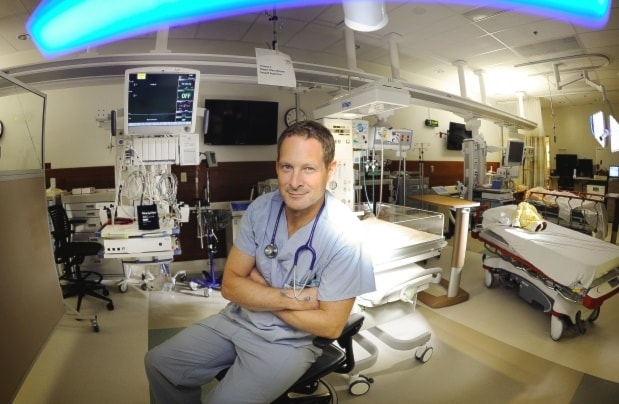SURREY — Patients have flooded Surrey Memorial Hospital’s new emergency department, raising concerns the nine-month old facility may already be over capacity.
The number of patients seeking treatment at Surrey’s ER has jumped 27.5 per cent since it opened Oct. 1, 2013, compared to the same period the previous year, show statistics from the Fraser Health Authority.
That’s far higher than the average six to seven per cent annual increase the ER has had in past years.
More than 10,000 patients a month routinely seek treatment at the Surrey ER, up from around 8,000 a month last year — though the figures fluctuate each month.
Nurses say the spike has overwhelmed the new ER and is leading to unacceptable crowding, long wait times and patients being treated in hallways.
The health authority insists the new facility can handle the extra traffic. It says that while wait times are up for some non-critical patients, there have been significant gains in providing quicker treatment for the critically ill.
The problem may be highlighted as part of a government review into Fraser Health, expected to be set up Wednesday by Health Minister Terry Lake.
The new Surrey ER is Canada’s second-largest, and B.C.’s busiest. It was five times larger than the old ER, adding 151 beds and expanding capacity by 30 per cent. It cost $512 million, and included a new walk-in and triage zone, acute care zone, trauma room, and separate mental health and substance abuse zones.
Fraser Health says 78,116 patients were treated at the new ER between Oct. 11 and May 22, up from 61,257 patients during the same time a year earlier.
“That’s a big jump,†said Dr. Craig Murray, chief of the Surrey ER.
But it’s also in some ways predictable, he said.
The number of children treated at the ER is up 31 per cent, mainly because the new ER has a separate pediatric department, said Murray. It’s B.C.’s second dedicated pediatric ER (there is one at BC Children’s Hospital).
“I think that resonates with the community outside of just the Surrey area,†he said. “And so we are definitely seeing patients that are coming from further away — Langley, Delta, White Rock, South Surrey, even further — to come to the pediatric ER.â€
Another reason for the increase include Surrey’s rapidly growing population.
And the new ER is a “draw†for people, said Murray.
“When you build a brand new ER there’s a certain cachet,†he said. “It’s new modern technology, advanced, and a better space. We’ve seen it every time someone built a new ER, there’s always been a draw to that ER.â€
ER visits were down in several other Fraser Health hospitals — Delta, Langley Memorial, Abbotsford Regional and Peace Arch, but were up at others — Burnaby, Royal Columbian and Eagle Ridge.
Nurses say the additional patients put the Surrey ER into a daily crisis.
“They have been overcapacity since the day they opened, as are the majority of emergency rooms and hospitals throughout the Fraser Valley,†said Debra McPherson, president of the BC Nurses Union.
“The demand is huge. For the nurses, its means their workloads are extremely heavy. They opened it without having it fully staffed and they never really got it fully staffed. They are overflowing with more patients than they have staff for, including patients lining hallways and being held in various corridors and triage areas.â€
The new ER is poorly designed, leading to slowdowns and inefficiencies in areas like admissions, said Neil Moncton from the Hospital Employees’ Union, which represents several dozen care aids, porters, lab assistants, pharmacy technicians, records staff, cleaners and registration staff at the hospital.
“When you are seeing people receiving treatment in the halls, and seeing the old ER being used as another acute care area where people are being put, you have to say it’s not meeting (demand).â€
The hospital has only had to treat patients in hallways once, in June, said Murray. There was a “surge†of really sick visitors and more than 400 patients in 24 hours, he said. The ER has capacity for around 180 to 200 patients.
The Surrey ER has nurse-to-patient and doctor-to-patient ratios comparable to similar hospitals, and has hired 200 staff since opening, he said. Administrators are tweaking physician schedules to match demand, as well as re-examining workflow in certain parts of the ER, said Murray.
Surrey has made significant progress reducing wait times for the most critically ill ER patients, those suffering from traumatic injuries, heart attacks or strokes, said Murray. The median wait time for a critical patient in April was 13 minutes, compared to 23 minutes in April 2013, said Fraser Health.
However, wait times are growing for people who visit the ER for some less serious matters, including cases that are more complicated to diagnose such as abdominal pain, weakness or dizziness. The median wait time for those cases from triage to seeing a physician was 135 minutes in April compared to 127 minutes the previous year.
Murray admitted there are also cases of ER patients waiting for days in ER beds for admission to hospital beds in the rest of the hospital.
“Hopefully that will come to an end,†he said. “It’s a lot better than it was a couple months ago, but it’s a reality in every ED [emergency department] I know of in Canada.â€
For more stories from the Vancouver Sun, click here.
